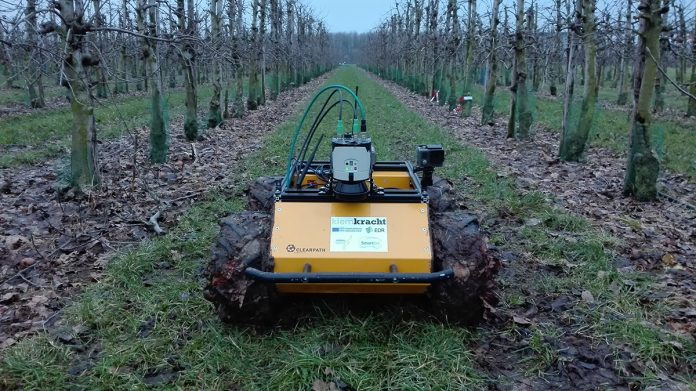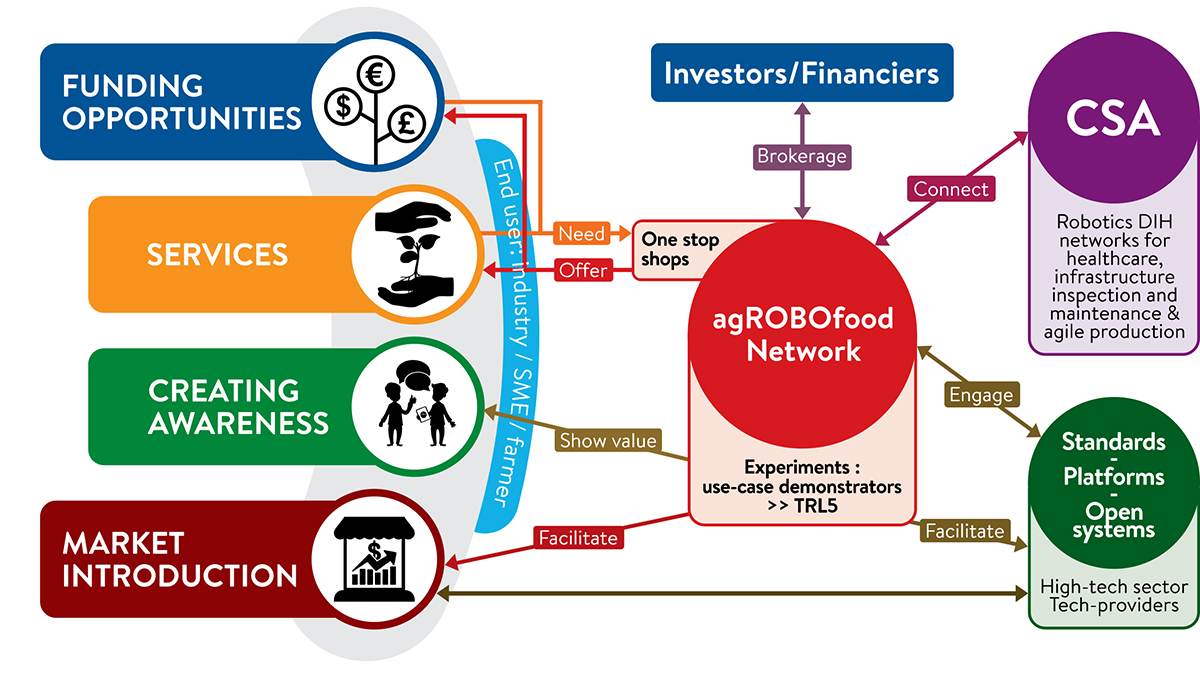Learn about building, loading and demonstrating a pan-European Digital Innovation Hub network for Robotics in Agri-food systems from experts of the agROBOfood project
This article is authored by Kees Lokhorst, agROBOfood project coordinator, Wageningen Research, Erik Pekkeriet, agROBOfood network coordinator, Wageningen Research and Grigoris Chatzikostas, agROBOfood deputy project coordinator, BIOS.
The H2020 funded agROBOfood project (grant number 825395) will develop a pan-European network of Digital Innovation Hubs (DIHs) and Competence Centers to stimulate implementation of high-tech robotic concepts for the agri-food sector and to demonstrate their applicability under practical circumstances.
The DIHs will act as (competence) centers of gravity, where various stakeholders such as developers, users, consultants and investors can interact and ensure synergy and cross-pollination of ideas, innovation and knowledge.
It is crucial not to duplicate infrastructures and facilities that are already in place but rather link them together
The agri-food sector is a dominant and vital component in the European economy, but under pressure to produce more food on less suitable land and for lower cost – and increasingly to protect the environment and stimulate biodiversity too. The workforce and working conditions are also under pressure, as fewer qualified (seasonal) workers are available for labour-intensive seasons such as harvest or cleaning. Also, environmental conditions are adapted more to the needs of plants, soils, barns and storages, which is not always beneficial for the workers. One way to combine these contradictory pressures is to increase the use of robotic sensing and automation in the agri-food industry.
Two other main directions are to work with more labour, either family-related or external, or with concepts of servitisation. Choices for these main directions differ per country, sector and organisation. Robotics and automatisation of processes are seen as an important solution. It facilitates precision and time and location related support actions in different types of farming (e.g. organic, precision and vertical farming). Robotics is capable to automate the heavier and more repetitive jobs e.g. in the food processing industry, reduces the need for seasonal workers, can supply 24/7 vigilance against pests and disease, increases food hygiene and improves food traceability. More food is available at a lower cost, to feed the increasing population. Successful robotics applications are for instance used commercially for milking, cultivating, spraying, harvesting, food processing, picking and placing food items, packaging and palletising.
Demand for food is outpacing available resources
The demand for food is outpacing available resources and it’s up to the agri-food industry to close this gap. Robots are helping them do just that.
The agri-food sector is partially automated but the level of adoption of robotics varies across the segments and the EU member states. The number of agricultural robots is increasing each year; the global agricultural robot market is anticipated to reach USD 8.82 billion by 20251. Europeans produce innovative technologies that could take a good share of this international market as well as benefitting European food producers. However, broad uptake of even established technologies is not common.
One reason is that the majority of agri-food companies are not aware of the current abilities of modern robots, nor the advantages that they bring. And if they are both aware and interested, they often do not have the skills, knowledge and business models to apply robotics in a way that best fits their needs. Agri-food robotics expertise in Europe is fragmented, which means both that it can be hard for a potential user to find the right support and that each supporting organisation is limited by the experience and expertise of its members.
Building the agROBOfood network
To overcome fragmentation of organisations working on digitalisation in Europe the EU promotes the concept of Digital Innovation Hubs and related Competence Centres. DIHs are one stop shops that are based upon technology infrastructures (Competence Centers) and provide access to the latest knowledge, expertise and technology to support their customers with piloting, testing and experimenting with digital innovations. DIHs also provide business and financial support to implement these innovations, if needed across the value chain.
As proximity is considered crucial, they act as a first regional point of contact, a doorway, and strengthen the innovation ecosystem. A DIH is a regional multi-partner cooperation (including organisations like RTOs, universities, industry associations, incubator/accelerators, regional development agencies and even governments) and can also have strong linkages with services providers outside of their region -supporting companies with access to their services (European Commission, 2018).
There are already many excellent organisations working in agri-food robotics across Europe, and many of them are gathered into this agROBOfood consortium. Some have roots in agriculture or food and are moving into robotics, others are experts in robots and want to apply these robots in agri-food. A key success factor is that agROBOfood already covers 24 European countries just through the 39 consortium partners and 41 associated partners at the start of the project. agROBOfood works in Europe with 7 Regional Cluster Coordinators with an ‘assignment’ to establish a DIH on robotics per country.
In this way we can take care of differences in degree of organisation and are able to work with ‘one-stop-shops’. The network is expected to grow during the project and will sustain after the agROBOfood project will be finished. A prerequisite is that members of the network will be pro-active and are willing to learn from each other to professionalise the services for customers. Since agROBOfood is not the only DIH network on digitalisation we are liaised to the CSA-RODIN partners DIH2, Trinity, RIMA and DIH-Hero, and to AGRI related projects like SmartAgriHub and IoF2020.
Loading the agROBOfood network
The agROBOfood network will be able to deliver a variety of services. TNO made an overview of the ecosystem, technical and business services. We will use these basics and professionalise our agROBOfood partners to able to deliver these services in the robotic field of expertise and to their customers. We will stimulate all the RIH to be able to deliver the full set of services to their customers. We support them by specific training and education and where needed we can develop a specific robot dedicated service. We will load the agROBOfood network with knowledge and experience on a variety of services.
Demonstrating the value of the agROBOfood network by Innovation Experiments
To demonstrate the value of the agROBOfood network and robotics in agri-food system we work with Innovation Experiments (IE) and Industrial Challenges (IC). In an IEs a small group of SME’s, startups and industrial partners work cross border together. Based on relative mature technology they work on and demonstrate robotic solutions. They also experiment with agROBOfood services and end users. We started with 7 IE and we will expand the IE and IC by having 3 open call rounds, with a total budget of 8 M€. The first open call is launched in March 2020.
References:
www.grandviewresearch.com/press-release/global-agricultural-robots-market1
Please note: This is a commercial profile













